GRADING REPORTS & INSCRIPTIONS
The American Gem Society (AGS) Laboratory was the first and foremost independent laboratory to issue numerical cut grades. Originally, this grade was based primarily on proportions measured on a Sarin Diamension machine. The AGSL now incorporates the performance of the diamond in its analysis. The highest grade is "0 Ideal." As a stone deviates from perfection, its numerical grade increases; 1 Excellent, 2 Very Good, all the way down to 10 Poor. As technology has improved, so has the grading.
The AGS grades eight aspects of cut of each stone it analyses. These include the Crown & Pavilion Angle, Pavilion Depth, Table Diameter, Girdle Thickness, Culet Size, Polish, Symmetry and Performance. The first five of these are grouped under the term "Proportion."
The AGS gives its highest cut grade to a stone that has achieved the highest (actually lowest "0") score on all four criteria: Polish, Symmetry, Proportion and Performance. Remember that not all AGS Triple Ideal Cuts achieve the more precise demands of Hearts & Arrows.
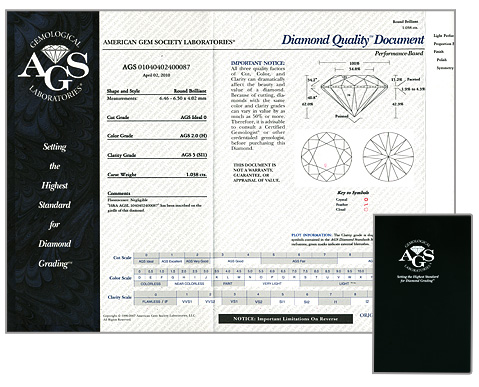
AGS Lab Diamond Quality Document
GIA Grading Reports - The GIA is the most recognized grading lab in the world. A few years ago, the GIA finally started providing a cut quality.
The GIA and AGS labs are the most consistent in their grading and abide by the highest standards. The primary difference between these two labs has to do with popularity. The AGS developed an early loyal following primarily of manufacturers specializing in the highest cutting standards. The GIA is better known as their grading reports did not mention cut quality until recently. Today's economy is a global market and the choice of one lab over the other will primarily depend on where the manufacturer of any given stone does the most business. The GIA is overwhelmingly the most recognized grading lab in the world today.
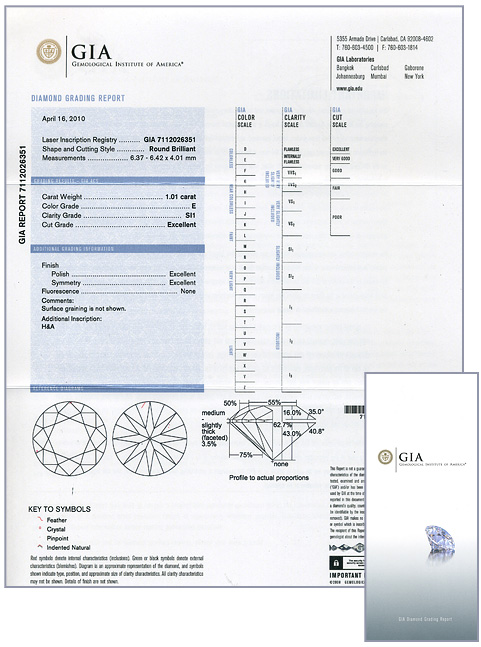
EGL Grading Reports - Why are EGL graded diamonds so much cheaper than AGS or GIA graded stones?
The simple answer is that gemological labs are not all held to the same grading standards. The EGL is more lenient in their grading than the GIA and AGS. Color differences can be as much as 3 to 5 color grades and clarity grades are typically 1 to 2 grades lower than GIA and AGS standards. As such EGL graded diamonds are priced lower.
For the purpose of this section, we will consider the AGS and GIA as equal in their standards of grading.
In the words of a very wise diamantaire: "The GIA is a tool for buying diamonds. The EGL is a tool for selling diamonds." That in a nutshell is the difference. The European Gem Lab does not have the same strict grading standards as do the GIA and AGS, thus they tend to be more lenient and inconsistent in their grading assessments. Simply put, this means that a diamond graded by the EGL would more than likely be graded lower by the GIA.
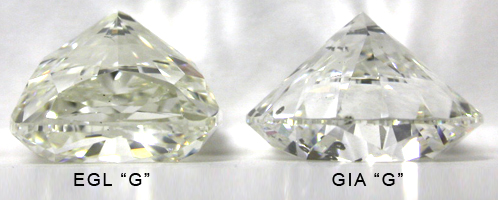

In the above pictures, we have compared EGL "G" colored stones to GIA “G” colored stones. As is plainly evident, the GIA graded stones are whiter than their EGL counterparts. If the above EGL stones were submitted to the GIA for color grading the results would be closer to J/K for the top one and considerably lower for the bottom one. These two images represent the range of leniency in the EGL grading compared to the GIA/AGS.
Unfortunately this means that if you are comparing an EGL F-SI1 and a GIA F-SI1 of the same carat weight you will not be comparing apples to apples and you should expect the EGL graded stone to cost less than the GIA stone. We have seen differences as great as 5 full color and/or 2 clarity grades between the labs. The price is reflective of the leniency of the grading.
For example:
| GIA | Round | 1.51 | F-SI1 | Excellent Cut | for $15,845 |
| AGS | Round | 1.54 | F-SI1 | Ideal Cut | for $16,160 |
| EGL | Round | 1.51 | F-SI1 | Excellent Cut | for $8,803 |
That is nearly a 50% difference (lower) price for the EGL graded diamond. Considering that you always get what you pay for, a safe assumption about this particular EGL diamond is that it is at 3 to 5 color grades and one or two clarity grades lower, by GIA standards. We should really read this stone as an I/J-SI2/I1 diamond by GIA standards. Looking at equivalent grades in the other labs we see that this really is no bargain:
| EGL Round | 1.51 | F-SI1 (really I/J-SI2/I1) | Excellent Cut | for $8,803 |
| GIA Round | 1.50 | J-SI2 | Excellent Cut | for $8,761 |
The above diamonds and prices are examples taken from our inventory in March 2012 for comparison and illustration only. These specific diamonds may not be available for sale.
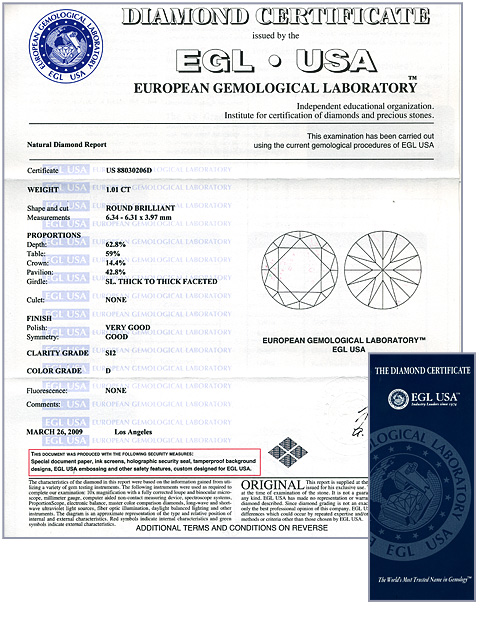
Laser Inscription
A laser inscription is a name or number that is burned into the diamond girdle to help identify it. The inscription is like an engraving that is not just on the surface but is etched or burned fractions of a millimeter into the diamond. Diamonds are laser inscribed when the manufacturer sends his stones for certification. Laser inscriptions are done by the grading labs and are usually mentioned on the grading reports. As this process adds significantly to the cost of the grading report, some manufacturers chose not to have their stones inscribed. If a diamond does not have a laser inscription, you can easily use the inclusion plot on the grading report to identify your stone. Every diamond has a unique arrangement of inclusions that can serve as a fingerprint.
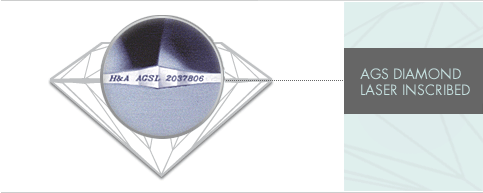
Most of the diamonds we list at Diamond Ideals have their report number laser inscribed in the girdle. This adds a degree of security, which can be useful in case you ever need to have your jewelry cleaned or repaired.
The black that you see in the laser inscription is actually burnt carbon residual left over from the laser burning. After the diamond is mounted, the jewelry cleaning process involves ultrasonic and steam cleaning, which may remove this carbon residue, making the inscription appear white or clear. This does not change the fact that the stone is laser-inscribed. While it may become more difficult to see under a loupe, the inscription on your diamond will still be visible when viewed under a microscope.
Here are a couple of magnified images depicting the visibility of the laser inscription before and after the carbon residue has been removed from cleaning.
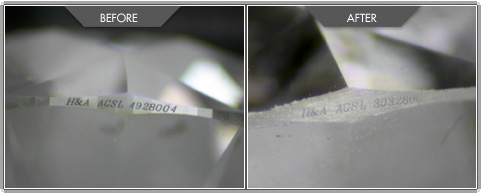
Were your questions answered? Click here to contact us today.






